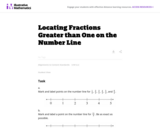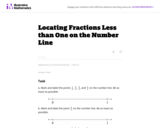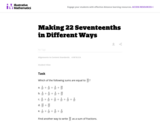![K-5 Math Teaching Resources: Pizza for Dinner [PDF]](https://openspace.infohio.org/static/newdesign/images/materials/default-thumbnail-index.png)
Explain using equalivalent fractions to determine who ate more pizza.
- Subject:
- Mathematics
- Material Type:
- Lesson
- Provider:
- K-5 Math Teaching Resources LLC
- Date Added:
- 08/07/2023
![K-5 Math Teaching Resources: Pizza for Dinner [PDF]](https://openspace.infohio.org/static/newdesign/images/materials/default-thumbnail-index.png)
Explain using equalivalent fractions to determine who ate more pizza.

Compare a division problem with whole numbers to a similar problem about dividing fractions in this interactive from KET. Students watch a video of a peer talking about a fraction problem that involves equal groups, with the number of groups unknown. They use Visualize It!, an interactive tool that allows students to create a visual model of each problem on the screen and then reflect on their peer's thinking and answer a quiz to test their own understanding.

Students think about how fractional measurements relate to scale models, learn about alternate ways of expressing scale ratios, and demonstrate understanding of fractions and scale in this interactive from KET. After watching video clips, students use the Notes tool in the interactive to comment on the peer's reasoning, answer questions about scale ratios, and determine the heights of real objects based on scale ratios and models.

Students think about how fractional measurements relate to scale models, learn about alternate ways of expressing scale ratios, and demonstrate understanding of fractions and scale in this interactive from KET. After watching video clips, students use the Notes tool in the interactive to comment on the peer's reasoning, answer questions about scale ratios, and determine the heights of real objects based on scale ratios and models.

Students watch a video that reveals a peer's thinking about multiplying mixed numbers and then demonstrate their understanding of the distributive property of multiplication in this interactive from KET. Students use the Notes tool to critique their peer's mathematical reasoning and then take quizzes and solve problems that require them to apply the distributive property to multiplying mixed numbers.

This lesson will teach 2 methods of finding the least common multiple. Students will then complete activities using both methods to figure out which method they prefer.

This is a challenging fraction comparison problem. The fractions for this task have been carefully chosen to encourage and reward different methods of comparison.

This task requires students to represent fractions on a number line.

In this number line task students must treat the interval from 0 to 1 as a whole, partition the whole into the appropriate number of equal sized parts, and then locate the fraction(s).

In this interactive, use logic to solve riddles involving flea circus high jumps. Then, add two consecutive jumps and place them on a vertical number line. This often requires you to find equivalent fractions with common denominators. Numbers are randomized so that you can answer riddles and place fleas on the number line multiple times. The accompanying classroom activity includes a fraction/decimal concept review and a response sheet to support the online work.

In this interactive, students use logic to solve three riddles involving a frog jumping contest and then place the contestants' jumps at the correct points on the number line. Numbers are randomized so that the frogs' placements on the number line are different each time one of the three riddles appears. The accompanying classroom activity provides a review of equivalent values of fractions and decimals and a response sheet to help students work with the interactive. Student and teacher materials are included.

In this interactive, students use logic to solve three riddles involving a frog jumping contest and then place the contestants' jumps at the correct points on the number line. Numbers are randomized so that the frogs' placements on the number line are different each time one of the three riddles appears. The accompanying classroom activity provides a review of equivalent values of fractions and decimals and a response sheet to help students work with the interactive.

n this interactive, students use logic to solve three riddles involving a frog jumping contest and then place the contestants' jumps at the correct points on the number line.

In this interactive, use logic to solve riddles involving a flea-jumping contest. Place each contestant's jump, represented by either a fraction or a decimal in both feet and inches, at the correct point on the vertical number line. Numbers are randomized so that riddles can be solved and fleas placed on the number line multiple times. The accompanying classroom activity includes a fraction/decimal concept review and a response sheet to accompany the online work.

In this interactive, use logic to solve riddles involving a flea-jumping contest. Place each contestant's jump, represented by either a fraction or a decimal in both feet and inches, at the correct point on the vertical number line. Numbers are randomized so that riddles can be solved and fleas placed on the number line multiple times. The accompanying classroom activity includes a fraction/decimal concept review and a response sheet to accompany the online work.

In this interactive, use logic to solve three riddles involving a jumping frog competition. Then, using knowledge of inequalities and rational numbers, place the frogs in the correct range from 0 to 5 on a number line. The fractions, mixed numbers, and decimals (in feet and inches) are randomized so that the range on the number line is different each time the riddles appear. The accompanying classroom activity includes a concept review and a response sheet handout to support the online work.

In this interactive, use logic to solve three riddles involving high-jump performers in a flea circus. Then, using knowledge of inequalities, place the fleas in the appropriate range on a vertical number line. Numbers are randomized so that the range on the vertical number line is different each time one of the three riddles appears. The accompanying classroom activity includes a fraction/decimal concept review and response sheets to support the online work.

The interactive activity has students place decimals and fractions on the correct place on a number line.

This task is a straightforward task related to adding fractions with the same denominator. The main purpose is to emphasize that there are many ways to decompose a fraction as a sum of fractions, similar to decompositions of whole numbers that students should have seen in earlier grades.

This tasks lends itself very well to multiple solution methods. Students may learn a lot by comparing different methods. Students who are already comfortable with fraction multiplication can go straight to the numeric solutions given below. Students who are still unsure of the meanings of these operations can draw pictures or diagrams.